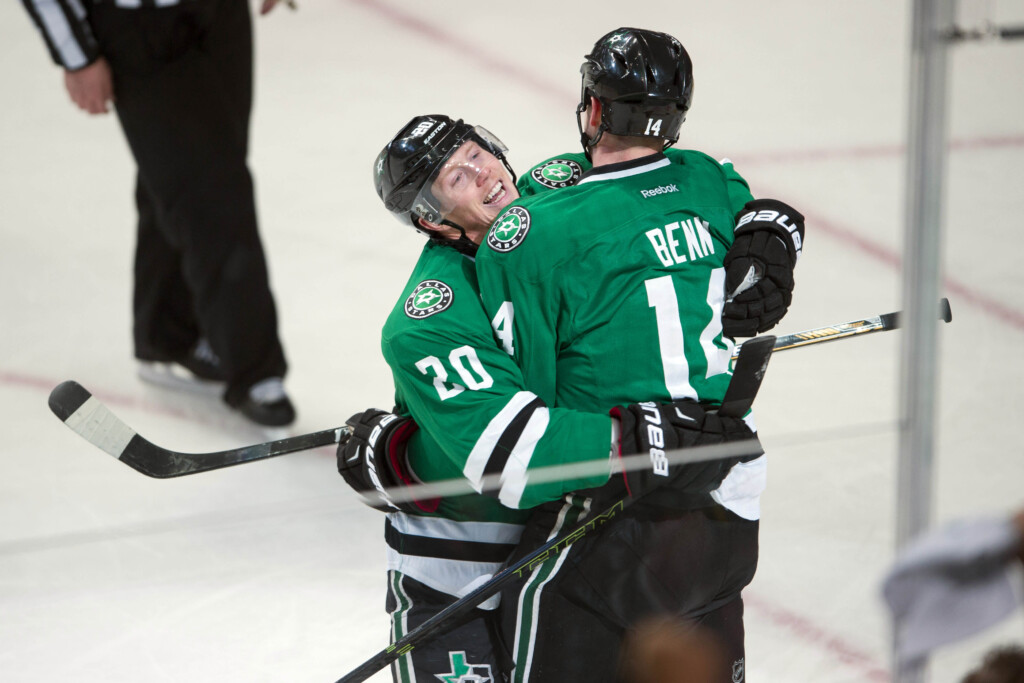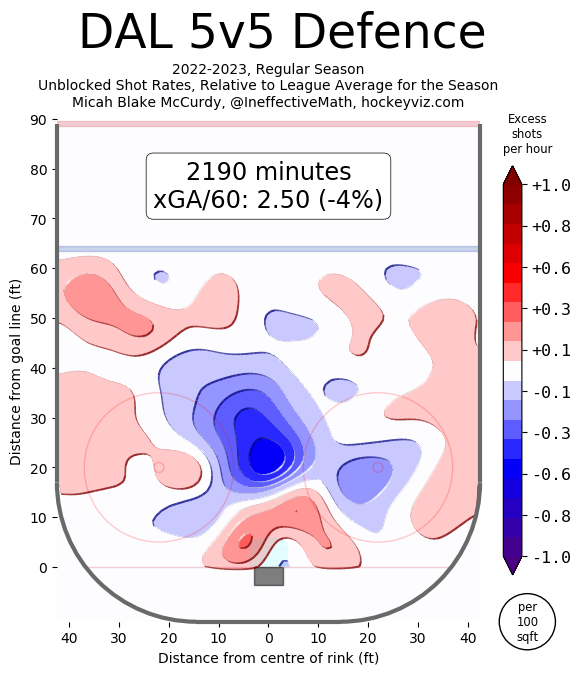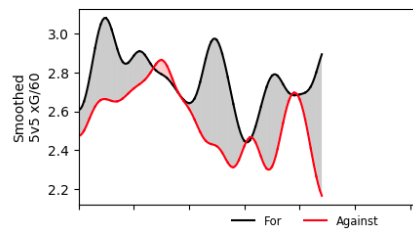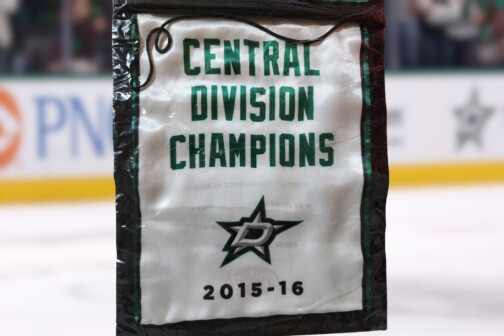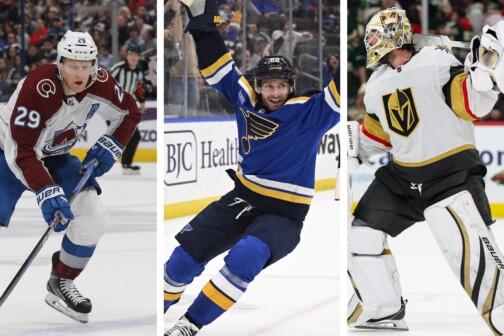We’re past the midway point of the NHL season and the Dallas Stars are in a good spot. They’re scoring goals, they’re getting saves, and they’ve been sitting at or near the top of the Western Conference all season. In other words, it’s been the type of campaign in which you’re probably sipping from your Fredrik Olofsson commemorative coffee mug in the break room just a bit more often than usual. Success tastes good.
Historically, Dallas has been a fairly successful franchise. In the three decades since arriving from Minnesota, the Stars have won a Stanley Cup and lost two more in the Cup Final. They’ve also hoisted eight divisional championship banners along the way. Other than a bit of a lull from 2008 to 2013, they’ve had a consistent presence in the postseason.
But anyone who’s been to American Airlines Center and gazed up at the rafters can’t help but notice that the bulk of those banners were hung in the Stars’ first decade in Dallas. Only one of those divisional championships have come in the last 15 years, which is hard to believe unless you are the credulous sort. (We sportswriters love the credulous sorts, almost as much as we love casually dropping words like “credulous” into articles to make ourselves feel well-read despite looking at Twitter for nine hours a day. Also, Bruce Springsteen and Marriott.)
Seven years ago, the Dallas Stars won the Western Conference with 109 points in the regular season. Lindy Ruff’s crew led the NHL in goals and were atop the conference standings for nearly the entirety of the regular season, despite some tough challenges from St. Louis and Chicago. No, Dallas didn’t bring home the Cup for their troubles, thanks to being forced to play Game 7 of the Western Conference semifinals against St. Louis without a goalie in net. But it was a lot of fun, and it was very impressive after missing the playoffs entirely a season earlier.
Barring a second-half meltdown, this Stars team profiles as the best regular-season squad since that 2015-2016 group. And given that their predecessor came up well short of ending what’s become a 24-year Cup drought, it’s only natural to wonder just how well these Stars stack up with that group, and whether there are any advantages that might make this bunch better suited to finish the job.
There are, and the first one might surprise you: this team has a stronger offense, technically. Seven years ago, Dallas scored 267 goals to lead the league in scoring; this year’s team is actually on pace to shatter that total with 284. And, yes, there are caveats. First, scoring is way up this year in the NHL. Second, that’s a heady goal-scoring pace to keep up for the rest of the season. Regardless, this is the first season since 2015-16 when the Stars haven’t been below league average in team shooting percentage, with their 10.7 percent rate well above sea level (and the 2015-16 team). That’s quite an accomplishment for a team playing a more balanced style, which is reflected in the Stars’ having the third-best NHL goal-differential at +35. They’re scoring the goals they ought to score, and it turns out there are quite a lot of them. They get to the scoring areas, and finish once they arrive. (Capitalizing on chances is just as important as creating them, as Rick Bowness discovered all too frequently.)
Scoring goals begets scoring more goals, too, as the Stars lead the NHL in empty-net goals with 13. This was a hallmark of the 2015-16 team, which scored a then-NHL record 24 ENGs, which was six more than the runner-up (San Jose). Ruff preached a relentless attacking mentality and a fierce willingness to shoot at empty nets, which ended a lot of games well before they could go south—like, say, when a game might be tied up by the opposing team in the final second of play, leading to a lost shutout for a goalie and a heartbreaking overtime loss on the road. You know, hypothetically speaking.
Ruff’s insistence on shooting at empty nets is not unlike Peter DeBoer’s this year, and you can see the logic in the approach. Hazarding an icing to put a game away for good isn’t any more of a risk than buckling down and praying for your goalie to save you. It’s often much less of one. The best defense is an offense that doesn’t require you to need your defense anymore, as the aphorism says. (We sportswriters love aphorisms, too.)
What’s more, the power play is outpacing even that vaunted 2015-16 unit’s 58-goal total. This year’s Stars are currently scoring 0.8 power-play goals per game, which would equate to an insane 66 power-play goals over the season. There have been cold snaps, but that unit has proven itself amply capable of course-correcting: after going a dreadful 1-for-20 in December, the power play turned around and went on a 12-for-28 heater. Much like the Stars have refused to lose three games in a row this season, their power play bends but never breaks. That ought to provide some encouragement in the midst of their current 2-for-18 rut.
So, the 2022-23 Stars are channeling the Ruffian offense of yesteryear, but they’re also built quite differently. Goaltending is the most crucial point of divergence. Jake Oettinger has been a top-five goaltender in the NHL this year, which is a significant improvement over Antti Niemi and Kari Lehtonen holding a damp washcloth between them. In addition to sporting one of the best save percentages in the league all year, Oettinger has also allowed two or fewer goals in eight of his last 10 starts. But the most telling stat might be this one: they are 3-0-3 in the six games allowing their highest amount of shots. In other words, the Stars have walked away with points from every single game in which they’ve surrendered 38 or more shots on goal. That’s some staunch netminding.
Oettinger proved last April that he can keep his team in the game even when they forget to play defense, but after plenty of offseason fretting about the blueline, the Stars have played defense, and quite well. That shouldn’t preclude a deadline move to bolster the defense, which Jim Nill has done almost every year the Stars have been in contention. But even if the Stars are forced to stand pat, their dominant win over Vegas on Monday showed just how effectively this team can prevent a potent offense from getting to Oettinger in the first place. For comparison’s sake, here is what the defense looked like in 2015-16 vs. this year:
This Stars team, unlike what happened in San Jose last night, has gotten more defensively sound as the season has gone on, as you can see by the generally declining red line denoting the quality of scoring chances allowed by Dallas this season in the HockeyViz graph below:
Make no mistake, this is not quite the Rick Bowness standard. But this group is sturdy enough, and it’s helped continue piling up points in Roope Hintz’s (hopefully brief) absence, like when Dallas picked up points against the Isles and Rangers despite scoring just two goals in 125 minutes of play.
All that to say, the Stars aren’t battling for the top of the Central Division because of one player or one part of their system; they have multiple strengths and not many weaknesses. They’re adaptable, and adaptability is one of the greatest strengths there is.
And that, most of all, is what may give the 2022-23 team the edge over Ruff’s group. Those Stars weren’t shy about who they were. Ruff ran an uptempo system that allowed a considerable amount of chances against, but they produced far more than they allowed. Over 82 games, that approach was repeatedly vindicated. Then came the playoffs, when Dallas’ goaltending got exposed. The Stars didn’t lose because their style of play was a bad one. They lost because it was their only one.
DeBoer’s group may not be a perfect bunch, but they’ve demonstrated the ability to compensate for any shortcomings in a variety of ways. Will that lead to another regular-season banner? If it does, it will deserve just as much fanfare as the 2015-2016 team. As Stars fans know all too well, seasons like this don’t come around all that often. But they’ll be hoping for more, too. And this team might have the versatility to deliver everything they want.
Get the ItList Newsletter
Author



